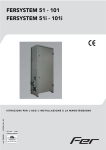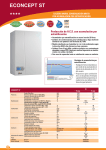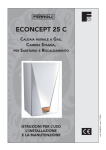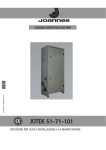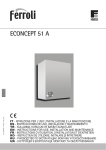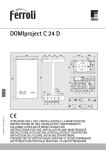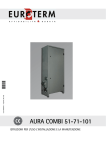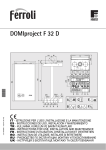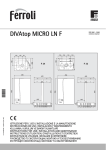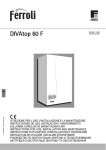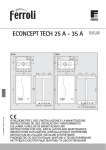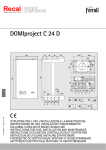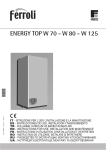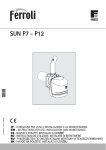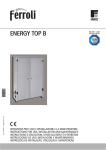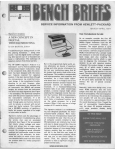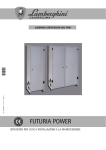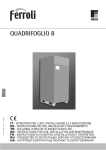Download Econcept 101 Manual
Transcript
cod. 3540S572 — 11/2010 (Rev. 00) 6 ECONCEPT 51 - 101 ECONCEPT 51i - 101i ISTRUZIONE PER L’USO L'INSTALLAZIONE E LA MANUTENZIONE INSTRUCCIONES DE USO, INSTALACIÓN Y MANTENIMIENTO KULLANMA, KURULUM VE BAKøM TALIMATLARø INSTRUCTIONS FOR USE, INSTALLATION AND MAINTENANCE INSTRUCTIONS D'UTILISATION, D'INSTALLATION ET D'ENTRETIEN INSTRUCğIUNI DE UTILIZARE, INSTALARE ùI ÎNTRETINERE ɊɍɄɈȼɈȾɋɌȼɈ ɉɈ ɗɄɋɉɅɍȺɌȺɐɂɂ, ɆɈɇɌȺɀɍ ɂ ɌȿɏɈȻɋɅɍɀɂȼȺɇɂɘ ȱɇɋɌɊɍɄɐȱə Ɂ ȿɄɋɉɅɍȺɌȺɐȱȲ, ɆɈɇɌȺɀɍ ɌȺ ɈȻɋɅɍȽɈȼɍȼȺɇɇə ECONCEPT 51/51i - 101/101i EN 1. GENERAL INSTRUCTIONS • Carefully read the instructions contained in this instruction booklet. • After boiler installation, inform the user regarding its operation and give him this manual, which is an integral and essential part of the product and must be kept with care for future reference. • Installation and maintenance must be carried out by professionally qualified personnel, according to current regulations and the manufacturer's instructions. Do not carry out any operation on the sealed control parts. • Incorrect installation or inadequate maintenance can result in damage or injury. The Manufacturer declines any liability for damage due to errors in installation and use or failure to follow the instructions. • Before carrying out any cleaning or maintenance operation, disconnect the unit from the power supply using the system switch and/or the special cut-off devices. • In case of a fault and/or poor operation, deactivate the unit and do not attempt to repair it or directly intervene. Contact professionally qualified personnel. Repair/replacement of the products must only be carried out by professionally qualified using original spare parts. Failure to comply with the above could affect the safety of the unit. • This unit must only be used for its intended purpose. Any other use is considered improper and therefore dangerous. • The packing materials are potentially hazardous and must not be left within the reach of children. • The images given in this manual are a simplified representation of the product. In this representation there may be slight and insignificant differences with respect to the product supplied. Eco (Economy) mode (with optional hot water tank installed) Heating mode Unit On / Off button Burner On Appears on connecting the Remote Timer Control (optional) Information symbol Top boiler shell Top boiler shell system fault reset request Fault Circulating pump On Appears on connecting the external probe (optional) Boiler Off Bottom boiler shell Bottom boiler shell system fault reset request (model ECONCEPT 101/ 101ionly) 12 = 13 = 14 = 15 = 16 = 17 = 18 = 19 = 20 = 21 = 22 = 23 = 24 = 25 = Indication during operation Heating A heating demand (generated by the Room Thermostat or Remote Timer Control or 010 Vdc signal) is indicated by activation of the circulating pump and the radiator (details 13 and 21 - fig. 1). The display (detail 11 - fig. 1) shows the actual heating delivery temperature and, during heating standby time, the message "d". Activation of the arrows (details 18 and 24 fig. 1) indicates which boiler shell is on. 2. OPERATING INSTRUCTIONS 2.1 Introduction Dear Customer, || |||| ||| ||| ECONCEPT 51/51i - 101/101i is a high-efficiency modular premix condensing heat generator for heating with very low emissions, running on natural gas or LPG and arranged for installation in cascade. Each ECONCEPT 51/51i - 101/101i module is equipped with a double aluminium lamellar exchanger and double ceramic premix burner housed in a vertical cabinet in AISI 316 stainless steel (version ECONCEPT 51i - 101i) or in epoxy powder coated steel resistant to atmospheric agents (version ECONCEPT 51 - 101). The plumbing circuits of the exchangers, each equipped with its own local circulating pump, run into system delivery and return manifolds inside the module. The control system has a microprocessor and user interface with a large display. ||||| |||| || Thank you for choosing ECONCEPT 51/51i - 101/101i, heat generator of the latest generation FERROLIfeaturing advanced design and cutting-edge technology. Please read this manual carefully since it provides important information on safe installation, use and maintenance. reset eco comfort reset eco comfort fig. 2 DHW (with optional hot water tank installed) A hot water tank heating demand is indicated by activation of the circulating pump and the tap (details 9 and 21 - fig. 1). The display (detail 11 - fig. 1) shows the actual hot water tank sensor temperature and, during heating standby time, the message "d". Activation of the arrows (details 18 and 24 - fig. 1) indicates which boiler shell is on. A cascade control unit, available by request, enables effective and economical management of the modules ECONCEPT 51/51i - 101/101i connected in cascade. The generators ECONCEPT 51/51i - 101/101i are designed for installation even outside. The versions ECONCEPT 51i - 101i with stainless steel cabinet are particularly recommended for places where the climatic and environmental conditions are unfavourable. 2.2 Control panel reset 16 17 19 18 20 23 5 eco comfort reset eco comfort fig. 3 Exclude hot water storage tank (economy) 22 11 2 4 21 Hot water tank temperature maintaining/heating can be excluded by the user. If excluded, domestic hot water will not be delivered. The hot water tank can be deactivated by the user (ECO mode) by pressing the eco/comfort button (detail 7 - fig. 1). In ECO mode the display activates the symbol (detail 12 - fig. 1). To activate the COMFORT mode, press the eco/comfort button (detail 7 - fig. 1) again. 2.3 Lighting and turning off 3 13 reset eco comfort 10 1 9 12 15 25 Boiler lighting Press the On/Off button (detail 14 fig. 1). A reset reset 6 8 14 24 • Key 1= • 8= 9= 10 = 11 = C reset The control panel is located inside the cabinet. To access it, open the front door with the special key supplied. 3= 4= 5= 6= 7= B 7 fig. 1 - Control panel 2= eco comfort eco comfort DHW temperature setting decrease button (with optional hot water tank installed) DHW temperature setting increase button (with optional hot water tank installed) Heating system temperature setting decrease button Heating system temperature setting increase button Display Summer/Winter mode selection button Economy/Comfort mode selection (with optional hot water tank installed) and unit On/Off button Reset button DHW operation (with optional hot water tank installed) Summer mode Multifunction eco comfort reset eco comfort fig. 4 - Boiler lighting • • For the following 120 seconds the display will show FH which identifies the heating system air venting cycle. During the first 10 seconds the display will also show the software version of the cards: A = Display card software version B = Top boiler shell control unit software version C = Bottom boiler shell control unit software version (model ECONCEPT 101/ 101ionly) Open the gas cock ahead of the boiler. When the message FH disappears, the boiler is ready to operate automatically in case of a room thermostat demand. cod. 3540S572 - 11/2010 (Rev. 00) EN 47 ECONCEPT 51/51i - 101/101i Turning the boiler off Press the button Room temperature adjustment (with optional room thermostat) (detail 7 - fig. 1) for 5 seconds. Using the room thermostat, set the temperature required in the rooms. Room temperature adjustment (with optional remote timer control) Using the remote timer control, set the temperature desired in the rooms. The boiler unit will set the system water according to the required room temperature. For information on the remote timer control, please refer to its user's manual. Sliding temperature When the optional external probe is installed the corresponding symbol (detailfig. 122 ) is activated on the control panel display (detail 5 - fig. 1). The boiler control system operates with "Sliding Temperature". In this mode, the heating system temperature is adjusted according to the outside weather conditions, to ensure high comfort and energy saving throughout the year. In particular, as the outside temperature increases, the system delivery temperature is decreased according to a specific "compensation curve". eco comfort reset fig. 5 - Turning the boiler off When the boiler is turned off, the PCB is still powered. Domestic hot water (with optional hot water tank installed) and heating operation are disabled. The antifreeze system remains activated. To relight the boiler, press the button (detail 7 fig. 1) again for 5 seconds. With Sliding Temperature adjustment, the temperature set with the heating buttons (details 3 and 4 - fig. 1) becomes the maximum system delivery temperature. It is advisable to set a maximum value to allow system adjustment throughout its useful operating range. The boiler must be regulated at the time of installation by qualified personnel. Adjustments can in any case be made by the user to improve comfort . Compensation curve and curve offset Press the button pensation curve (details Adjust the required curve from 1 to 10 according to the characteristic (fig. 12). eco comfort reset reset (detail 8 - fig. 1) for 5 seconds, to display the actual com(fig. 10) which can be modified with the DHW buttons 1 and 2 - fig. 1). By setting the curve to 0, sliding temperature adjustment is disabled. fig. 6 The boiler will be immediately ready to operate whenever domestic hot water is drawn (with optional hot water tank installed) or in case of a room thermostat demand. II The antifreeze system does not work when the power and/or gas to the unit are turned off. To avoid damage caused by freezing during long idle periods in winter, it is advisable to drain all water from the boiler, DHW circuit and system; or drain just the DHW circuit and add a suitable antifreeze to the heating system, complying with that prescribed in sec. 3.3. IIII IIIII III eco comfort reset fig. 10 - Compensation curve 2.4 Adjustments Press the heating buttons (details 3 and 4 - fig. 1) to access parallel curve offset (fig. 13), modifiable with the DHW buttons (details 1 and 2 - fig. 1). Summer/Winter Switchover Press the button I B II III IIIIIIIIIII To completely disconnect the power to the unit, press the button detail 14 fig. 1. detail 6 - fig. 1 for 1 second. III III II III II IIIII IIIII IIIIIIIIIII eco comfort reset eco comfort reset fig. 7 fig. 11 - Curve parallel offset The display activates the Summer symbol detail 10 - fig. 1. The heating function is deactivated, whereas the possible production of domestic hot water (with optional external hot water tank) remains activated. The antifreeze system remains activated. To deactivate Summer mode, press the button ond. (detail 6 - fig. 1) again for 1 sec- Press the button adjustment mode. (detail 8 - fig. 1) again for 5 seconds to exit parallel curve reset If the room temperature is lower than the required value, it is advisable to set a higher order curve and vice versa. . Proceed by increasing or decreasing in steps of one and check the result in the room. Heating temperature adjustment 90 85 80 Use the heating buttons (details 3 and 4 - fig. 1) to adjust the temperature from a min. of 20°C to a max. of 90°C. 10 9 8 7 6 5 4 70 IIIII 2 IIIII 50 III IIIIIII 3 60 IIIII III 1 IIIIII 40 reset eco comfort 30 fig. 8 20 DHW temperature adjustment (with optional hot water tank installed) 20 Use the DHW buttons (details 1 and 2 - fig. 1) to adjust the temperature from a min. of 10°C to a max. of 65°C. 10 0 -10 OFFSET = 20 IIIII IIIII ||||| | |||||| | ||| ||| reset fig. 9 OFFSET = 40 90 85 80 IIIII eco comfort -20 fig. 12 - Compensation curves 10 9 8 6 5 70 4 60 3 50 2 40 1 30 20 7 20 10 0 -10 -20 90 85 80 10 9 8 7 EN cod. 3540S572 - 11/2010 (Rev. 00) 5 4 3 70 2 60 1 50 40 30 20 20 10 0 fig. 13 - Example of compensation parallel curve offset 48 6 -10 -20 ECONCEPT 51/51i - 101/101i If the Remote Timer Control (optional) is connected to the boiler, the above adA justments are managed according to that given in table 1. Table. 1 Heating temperature adjustment DHW temperature adjustment (with optional hot water tank installed) Summer/Winter Switchover Eco/Comfort selection (with optional hot water tank installed) Sliding Temperature Adjustment can be made from the Remote Timer Control menu and the boiler control panel. Adjustment can be made from the Remote Timer Control menu and the boiler control panel. Summer mode has priority over a possible Remote Timer Control heating demand. On disabling DHW from the Remote Timer Control menu, the boiler selects the Economy mode. In this condition, the button fig. 1detail 7 - on the boiler panel is disabled. On enabling DHW from the Remote Timer Control menu, the boiler selects the Comfort mode. In this condition it is possible select one of the two modes with the button detail 7 -fig. 1. Both the Remote Timer Control and the boiler card manage Sliding Temperature adjustment: of the two, the Sliding Temperature of the boiler card has priority. 3.3 Gas and water connections Plumbing connections Make the relevant connections according to the instructions given below. Make the generator connection in such a way that its internal pipes are free of stress. For proper operation and long life of the generator, the plumbing system must be of suitable size and complete with all the accessories that guarantee regular operation and running. In particular, provide for all the protection and safety devices prescribed by current regulations for the complete modular generator. They must be installed on the hot water circuit delivery piping, immediately downstream of the last module, within a distance of 0.5 m, with no shut-off devices in between. A "Safety Device and Circuit Breaker module” equipped with internal hydraulic circuit breaker and safety units with ISPESL certification is available by request. Refer to the price-list or contact our sales network. The unit is not supplied with an expansion tank; its connection must therefore be made by the Installer. B System water pressure adjustment The filling pressure with the system cold must be approx. 1.0 bar. If the system pressure falls to values below minimum, the boiler card will activate fault F37 (fig. 14). Flashing of the arrows (details 18 and 24 - fig. 1) together with the error code indicates which boiler shell is in fault status. III I I IIIII IIIIIIIIIIIIIII III IIIIIII IIIIII III III III I I II I I I I I I I I I I I I II I I reset The filter must necessarily be installed when replacing generators in existing systems. The manufacturer declines any liability for damage caused to the generator by failure to install or inadequate installation of this filter. Water system characteristics In the presence of water harder than 25° Fr, it is advisable to use suitably treated water, in order to avoid possible scaling in the boiler caused by hard water, or corrosion produced by aggressive water. Due to its low thermal conductivity, scaling even just a few mm thick causes significant overheating of the generator walls, with consequent serious problems. Water treatment is indispensable in case of very large systems (containing large amounts of water) or with frequent introduction of replenishing water in the system. If partial or total emptying of the system becomes necessary in these cases, it is advisable to refill with treated water. III IIIII III I I I I I I I I I I III II III III I II A filter must also be installed on the system return piping to prevent impurities or sludge from the system clogging and damaging the heat generators. Gas connection eco comfort The gas must be connected to the corresponding union with a rigid metal pipe. III fig. 14 - Low system pressure fault the system pressure is restored, the boiler will activate the 120-second A Once air venting cycle indicated on the display by FH. 3. INSTALLATION 3.1 General Instructions The gas meter must be adequate for the simultaneous use of all units connected to it. Carry out the generator gas connection in accordance with current regulations. The diameter of the gas pipe leaving the generator does not determine the diameter of the pipe between the unit and the meter; it must be chosen according to its length and pressure loss. B Make sure to install a fuel shutoff valve externally with respect to the modules, enabling the gas to be turned off even without opening the single modules equipped with key closing. THE BOILER MUST ONLY BE INSTALLED BY QUALIFIED PERSONNEL, IN COMPLIANCE WITH ALL THE INSTRUCTIONS GIVEN IN THIS TECHNICAL MANUAL, THE PROVISIONS OF CURRENT LAW, THE NATIONAL AND LOCAL REGULATIONS, AND THE RULES OF PROPER WORKMANSHIP. Connection instructions ECONCEPT 51/51i - 101/101i is a high-efficiency heat generator arranged to operate alone or in cascade (bank). When two or more generators ECONCEPT 51/51i - 101/101i are installed in cascade with the original kits FERROLI, respecting the prescriptions of this manual, they can be considered as a single heat generator of total power equal to the sum of the powers of all the units connected in cascade. ECONCEPT 51/51i - 101/101i is equipped inside with 3 manifolds (gas, system delivery and return) and a condensate drain pipe that facilitate cascade connection and also connection of a single module to the system. The manifolds are sized for connecting up to 5 modules in series. The cabinet contains a set of flanges, seals and screws for the connection. All the requirements of the current standards and regulations applicable to this “equivalent” generator with total heating capacity must be met. In particular the place of installation, safety devices and fume exhaust system must be adequate for the total heating capacity of the bank of units. To connect a single module - fig. 16 In fact, each ECONCEPT 51/51i - 101/101i is a complete and independent heat generator, equipped with its own safety devices. In case of overtemperature, a lack of water or no circulation in the unit, the protection devices cause the unit to switch off or shut down, preventing it from working. The installation instructions given in the following paragraphs concern both single units and connection in cascade. 3.2 Place of installation The generator can be installed directly outside or in a suitable room with ventilation openings to the outside as prescribed by the current regulations. If there are several burners or extraction units that can work together in the same room, the ventilation openings must be sized for simultaneous operation of all the units. The place of installation must be free of flammable objects or materials, corrosive gases, volatile substances or dusts. For positioning, leave enough space around the modules for normal maintenance operations. Make sure the front door opens without hindrance. B The air necessary for combustion enters through special openings in the bottom and top part of the unit. Make sure these air passages are not obstructed in any way. • • • After determining on which side of the module to make the water and gas connections, connect the flanges with the joining section contained in the kit on that side after suitably welding them to the system pipes. Make sure to correctly to fit the seals contained in the kit. Connect a Ø40 pipe to the condensate drain pipe for removing the condensate produced during operation (see fig. 37). Fit the blind flanges contained in the kit on the opposite side of the module, inserting the special seals. To connect several modules in cascade - fig. 17 • • • • • Connect the first module to the system and gas pipes, as described above, but without fitting the blind flanges on the opposite side to that of the connection. Place the second module on this side, making sure to align the connection flanges and the condensate drain pipe. Insert the seals contained in the kit between the flanges of the two modules. Fit the bolts contained in the kit on the flanges from inside the first module, making them come out of the flanges inside the second module. Partially tighten the nuts on the bolts from inside the second module. Before tightening the nuts, make sure all the seals are correctly positioned and join the condensate drain pipes of the two modules (see fig. 38). Tighten the nuts and repeat the connection operations for the following modules (max.5). If using a water trap • At the end, fit the blind flanges on the last module, inserting the special seals (fig. 16 and fig. 17). If using a direct pump • Connect the delivery to the return on the last module (see fig. 18). fig. 15 - Air inlet cod. 3540S572 - 11/2010 (Rev. 00) EN 49 ECONCEPT 51/51i - 101/101i Plumbing connection using one generator with water trap "Service Menu" Press the Reset button for 10 seconds to access the card Service Menu. 1 Press the Heating buttons to select "tS", "In", "Hi" or "rE"”. “tS” means Transparent Parameters Menu, “In” Information Menu, “Hi” History Menu, and “rE” History Menu Reset. Select "tS" and press the Reset button. 1 2 2 3 The card has 29 transparent parameters also modifiable from Remote Control (Service Menu). Press the Heating buttons to scroll the list of parameters in increasing or decreasing order. Press the DHW buttons to modify the value of a parameter: the change will be automatically saved. 3 Press the Reset button to return to the Service Menu. Press the Reset button for 10 seconds to exit the card Service Menu. 5 6 7 "System Type Menu" 4 Press the Summer/Winter button for 10 seconds to access the card System Type Menu. The card has 21 transparent parameters. fig. 16 Press the Heating buttons to scroll the list of parameters in increasing or decreasing order. Press the DHW buttons to modify the value of a parameter: the change will be automatically saved. Gas inlet System delivery System return Condensate drain Blind flanges Connection side Flanges with joining section 1 2 3 4 5 6 7 Press the Summer/Winter button for 10 seconds to exit the card System Type Menu. One direct heating circuit Check/Change parameter P02 of the "Transparent Parameters Menu" to 1. Change parameter P.02 of the "System Type Menu" to 1. Plumbing connection using two or more generators with hydraulic separator Change parameter P.09 of the "System Type Menu" to 1. 1 1 2 2 138 3 5 7 7 6 7 72/139 3 4 fig. 17 Gas inlet System delivery System return Condensate drain Blind flanges Connection side Flanges with joining section Seals 1 2 3 4 5 6 7 8 I Plumbing connection using one or more generators with direct pump 298 D 306 1 1 A 2 2 fig. 19 3 3 One direct heating circuit and one DHW circuit with pump Check/Change parameter P02 of the "Transparent Parameters Menu" to 2. 8 9 8 6 7 4 Change parameter P.09 of the "System Type Menu" to 1. fig. 18 1 2 3 4 5 6 7 8 9 Change parameter P.02 of the "System Type Menu" to 1. Gas inlet System delivery System return Condensate drain Blind flanges Connection side Flanges with joining section Seals Delivery/return connection 138 72/139 Water circuit examples 42 Key of examples I ISPESL safety devices D Hydraulic separator 42 DHW temperature sensor (not supplied) 72 Room thermostat (not supplied) 72b Room thermostat (not supplied) 95 3-way valve - with spring return: at rest on DHW side (not supplied) 130 Hot water tank circulating pump (not supplied) 138 External probe (not supplied) 139 Remote control (not supplied) 298 Cascade temperature sensor (not supplied) 306 Heating system circulating pump (not supplied) 307 Heating system second circulating pump (not supplied) SM Delivery probe (supplied with kit FZ4) TS Safety thermostat (not supplied) PZ Zone pump (not supplied) FZ4 Zone regulator Parameters Each system requires a different parametrisation.Follow the procedure for accessing the two menus, given below; for the parameters to be modified, refer to the tables given next to the plumbing diagrams. 50 EN cod. 3540S572 - 11/2010 (Rev. 00) I 130 298 D 306 B fig. 20 ECONCEPT 51/51i - 101/101i One direct heating circuit and one DHW circuit with diverter valve Two mixed heating circuits, one direct heating circuit and one DHW circuit with pump Check/Change parameter P02 of the "Transparent Parameters Menu" to 3. Check/Change parameter P02 of the "Transparent Parameters Menu" to 2. Change parameter P.02 of the "System Type Menu" to 1. Change parameter P.02 of the "System Type Menu" to 1. Change parameter P.09 of the "System Type Menu" to 1. Change parameter P.09 of the "System Type Menu" to 1. Change parameter P.11 of the "System Type Menu" to 1. For the electrical connection and the zone system settings, refer to the "FZ4 zone regulator" handbook FZ4 138 72/139 72/139 138 72/139 Zona 1 72/139 Zona 2 Zona 3 42 TS 42 TS I PZ I PZ SM M PR 130 SM M 298 D 298 D 306 95 F fig. 24 C fig. 21 3.4 Electrical connections Connection to the electrical grid B Two direct heating circuits Check/Change parameter P02 of the "Transparent Parameters Menu" to 1. Change parameter P.01 of the "System Type Menu" to 4. Change parameter P.02 of the "System Type Menu" to 1. Change parameter P.09 of the "System Type Menu" to 1. The boiler is prewired and provided with a Y-cable and plug for connection to the electricity line. The connections to the grid must be made with a permanent connection and equipped with a bipolar switch whose contacts have a minimum opening of at least 3 mm, interposing fuses of max. 3A between the boiler and the line. It is important to respect the polarities (LINE: brown wire / NEUTRAL: blue wire / EARTH: yellow-green wire) in making connections to the electrical line. During installation or when changing the power cable, the earth wire must be left 2 cm longer than the others. 138 72b 72/139 The unit's electrical safety is only guaranteed when correctly connected to an efficient earthing system executed according to current safety standards. Have the efficiency and suitability of the earthing system checked by professionally qualified personnel. The manufacturer is not responsible for any damage caused by failure to earth the system. Also make sure that the electrical system is adequate for the maximum power absorbed by the unit, as specified on the boiler dataplate. B I The user must never change the unit's power cable. If the cable gets damaged, switch off the unit and have it changed solely by professionally qualified personnel. If changing the electric power cable, use solely “HAR H05 VV-F” 3x0.75 mm2 cable with a maximum outside diameter of 8 mm. Room thermostat (optional) 307 B 306 298 D D fig. 22 CAUTION: The room thermostat must have clean contacts. CONNECTING 230 V. TO THE TERMINALS OF THE ROOM THERMOSTAT WILL IRREPARABLY DAMAGE THE ELECTRONIC CARD. When connecting a remote timer control or a timer switch, do not take the power supply for these devices from their cut-out contacts. Their power supply must be taken with a direct connection from the mains or with batteries, depending on the kind of device. External probe (optional) Two mixed heating circuits and one direct heating circuit Check/Change parameter P02 of the "Transparent Parameters Menu" to 1. Change parameter P.02 of the "System Type Menu" to 1. Change parameter P.09 of the "System Type Menu" to 1. For the electrical connection and the zone system settings, refer to the "FZ4 zone regulator" handbook Connect the probe to its respective terminals. The maximum permissible length for the boiler - external probe connection electrical cable is 50 m. A normal 2-wire cable can be used. The external probe should preferably be installed on the North, North-West wall or that facing the largest area of living room. The probe must never be exposed to the early morning sun or, insofar as possible, direct sunlight; protect it if necessary. In any case, the probe must not be installed near windows, doors, ventilation openings, flues or heat sources that could affect the reading. FZ4 72/139 138 72/139 Zona 1 72/139 Zona 2 TS Zona 3 TS I PR PZ PZ SM M SM M 298 D fig. 25 - External probe positioning not recommended E fig. 23 cod. 3540S572 - 11/2010 (Rev. 00) EN 51 ECONCEPT 51/51i - 101/101i Accessing the electrical terminal block 3.5 Flue connection The electrical terminal block is located inside a sealed box at the bottom left of the cabinet. Make the electrical connections as shown in the wiring diagram on sec. 47 and run the cables through the special cable glands. Important 4 5 6 7 8 9 A ( (( 300 306 10 11 12 B 25 26 27 28 29 30 Manifold, ducts and flue must be suitably sized, designed and made in compliance with current regulations. These must be made of suitable materials, i.e. resistant to heat and corrosion, smooth on the inside and hermetic. In particular, joints must be condensate tight. Also provide for suitable condensate drain points, connected to a trap to prevent the condensate formed in the flues from running into the generators. C ( 301 302 130/307 95 13 14 15 16 17 18 19 20 21 22 23 24 B 72 138 299 298 72B 42 139 fig. 26 - Electrical terminal block DHW temperature sensor (not supplied) Room thermostat (not supplied) Room thermostat (not supplied) Diverter valve (not supplied) 42 72 72b 95 The unit is a B23 type with combustion air drawn from the installation room and fume exhaust by means of a fan (operation with flue pressurised) and must be connected to one of the discharge systems indicated below. Before proceeding with installation, check and carefully comply with the local regulations and provisions. Also comply with the provisions concerning the positioning of wall and/or roof terminals and minimum distances from windows, walls, ventilation openings, etc. The unit is equipped with two separate Ø80 flue connections for the two burner - exchanger units (fig. 28) located inside the cabinet. The combustion circuits of the two units are completely independent. When joining the two fume outlets to a single flue or manifold (in case of a single module or connection in cascade) it is necessary to install a fume anti-backflow valve on each outlet to prevent operation anomalies or to creation of hazardous conditions. Make sure to use the optional kits FERROLI, provided with special anti-backflow valves for installing inside the cabinets, in a position protected against the atmospheric agents. carrying out the flue connection, make sure to fill the condensate tank A Before as indicated incap. 3.6. A = Heating phase 700 B = DHW phase 250 C = Neutral NOTE: For valves with 2 wires and spring return, use the connections B and C DHW circulating pump (not supplied) External probe (not supplied) Remote timer control (not supplied) Cascade temperature sensor (not supplied) Input 0-10 Vdc Burner lit contact (voltage-free contact) Fault contact (voltage-free contact) Remote reset input (230 Volt) Heating system circulating pump (not supplied) Heating system second circulating pump (not supplied) 130 138 139 298 299 300 301 302 306 307 200 Ø80 250 Ø80 For connection in cascade (MAX. 5 MODULES) 1. Connect the modules as shown in fig. 27 (example with 4 modules) B C D 25 26 27 28 29 30 25 26 27 28 29 30 25 26 27 28 29 30 1650 A 25 26 27 28 29 30 fig. 27 - Connection in cascade A B C D 2. 3. 4. 5. 1st Module 2nd Module 3rd Module 4th Module Carry out all the electrical connections (terminals 4 to 24) on module no. 1 On the remaining modules only connect the power supply and possible contacts for: burner lit (300), fault contact (301) and remote reset input (302). Switch on the power to the entire cascade After the "FH" procedure, check correct operation of the cascade: • • • • Module 1: arrow symbol at top left of the display Module 2: arrow symbol at bottom right of the display Module 3: arrow symbol at bottom right of the display Module 4: arrow symbol at top right of the display If this does not occur, disconnect the power and check the wiring in fig. 27. Settings All adjustments must be made on all the modules. Possible faults If the electrical connection of a module is disconnected for any reason, module 1 will activate fault F70. If the electrical connection of a module is disconnected for any reason, the next module will activate fault F71. 52 EN cod. 3540S572 - 11/2010 (Rev. 00) fig. 28 ECONCEPT 51/51i - 101/101i Connection with separate pipes Connection with manifolds Separate Ø80 ducts can be connected directly to the unit. Insert the seal 1KWMA84A on the Ø80 pipes leaving the unit and make it adhere to the upper wall of the cabinet. To connect one or more modules in bank to a single flue, it is advisable to use the special manifolds (optionals) indicated in the table. The choice of diameter must be made according to the total power of the bank of units, respecting that given in the table. Use a starting kit for each bank and a suitable number of extension kits. Before proceeding with installation, make sure the maximum permissible length has not been exceeded, by means of a simple calculation: 1. Establish the layout of the system of split flues, including accessories and outlet terminals for each of the two burner/exchanger bodies. Consult the table 3 and identify the losses in meq (equivalent metres) of every component, according to the installation position. Check that the sum total of losses is less than or equal to the maximum permissible length in table 2. 2. 3. The starting kits have a special accessory inside them for connection also to modules ECONCEPT 51/51i. 90° bends and manifold extensions are also available for the flue connection. Bank heating capacity Manifold diameter Table. 2 - Max. length separate ducts For each single Exchanger/Burner Body 20 meq Max. permissible length 125 mm 160 mm 200 mm Up to 150 kW 150 - 300 kW 300 - 500 kW Separate ducts Starting kit Extension kit 041008X0 041009X0 041010X0 041020X0 041011X0 041012X0 Manifold extension 90° bend Male-female for manifold 1000 mm 041017X0 041014X0 041018X0 041015X0 041019X0 041016X0 Installation examples 041008X0 Table. 3 - Accessories Ø 125 Losses in meq Fume exhaust Ø 80 Vertical Horizontal 1.6 2.0 PIPE 1 m M/F 1KWMA83W BEND 45° M/F 1KWMA65W 90° M/F 1KWMA01W 2.0 1KWMA70W 0.3 TERMINAL fumes, wall with antiwind 1KWMA86A 5.0 FLUE Split air/fumes 80/80 1KWMA84U 5.0 PIPE SECTION with test point 041017X0 041014X0 1.8 Direct connection of terminals Ø 80 code 041013X0 Each single module can be connected directly to the terminal kits 041013X0 as given in , even with connection in bank fig. 29. Each kit comprises a Ø80 terminal with grille (ref. 3), a seal (ref. 1) and a centering ring (ref. 2). For models ECONCEPT 101/101i use 2 kits per module, and 1 kit for models ECONCEPT 51/51i. fig. 31 - Installation of one module 3 1 041016X0 041010X0 Ø 200 2 A 041012X0 A+5 041012X0 A+10 041012X0 A+15 041012X0 A+20 A+25 fig. 29 B Before installing the flues, open the cabinet and fill the trap with approx. 0.5 l. of water through the flue connections (see fig. 30) A and B for the model and ECONCEPT 101/101ionly A the model ECONCEPT 51/51i. fig. 32 - Installation of 5 modules For installation: fig. 33 A B fig. 30 - Filling the trap B For outside installations make the seal 1 adhere perfectly to the top part of the cabinet, to prevent possible infiltration of rain and atmospheric agents. C Insert the diameter 100 M-F pipe sections with fume inspection “1” and the respective seals “2” from the outside of the modules for each flue connection. Respect the distance given in the box “B“ of fig. 33. This distance must be increased by 5 mm with each additional module. Open the cabinets and install the anti-backflow valve “3” on eachflue connection D=80mm cod. 3540S572 - 11/2010 (Rev. 00) EN 53 ECONCEPT 51/51i - 101/101i 3.6 Condensate drain B The boiler has an internal condensate drain trap connected to an internal condensate outlet manifold. Condensate drain connection using one generator 1 fig. 34 D E F Make sure to correctly fit the seals. Lengthen the diameter 100mm extensible part of each valve until it rests on the inner part of the casing. Fix with the screw “4”. Pour 1/2 litre of water on each flue in order to fill the respective traps and anti-backflow valves. Repeat the above steps for all the flue connections of the modules. A B 2 fig. 37 - Condensate drain connection with one generator Place the Ø40 pipe 1 (not supplied) on the side of the generator. Slide the pipe 2 towards the side of the arrow for at least 2-3 cm in order to insert it in the pipe 1. A B Condensate drain connection using two or more generators 1 A fig. 35 G H Fit the manifold support flanges “5“ using the special holes provided on the top of the modules. The starting bracket on the first module must respect the distance of 45 mm. (see box “G” fig. 35). This distance must be increased by 5 at a time in the following modules, in order to obtain the fume manifold angle as indicated in fig. 32. Fit the condensate trap “6” support bracket on the flange of the first module. Insert the 90° M-F bends “8” on the pipe sections “7”, positioning them at 45° with respect to the module (see box “H” fig. 35). When installing a module ECONCEPT 51/51i use only one 90° bend and the cap contained in the starting kit. 2 2 B fig. 38 - Condensate drain connection with several generators Place the Ø40 pipe 1 (not supplied) on the side of the generator Slide the pipe 2 (of each generator) towards the side of the arrow for at least 23 cm in order to insert it in the pipe 1. A B 4. SERVICE AND MAINTENANCE All adjustment, conversion, commissioning and maintenance operations described below must only be carried out by Qualified Personnel (meeting the professional technical requirements prescribed by current regulations) such as those of the Local After-Sales Technical Service. FERROLI declines any liability for damage and/or injury caused by unqualified and unauthorised persons tampering with the unit. fig. 36 L M N A Fit the flue pipes together (operation to be carried out on the ground) , ensuring the alignment of the various connections “9” and respecting the coupling measurement of 705 mm (see box “L” fig. 36). Place the manifolds connected together on the support flanges and gradually insert all the bends on the previously fitted diameter 100 pipe sections. Check the correct angle of the manifold (see fig. 32) and the correct fitting of all the pipe sections, bends and valves, making sure the seals are properly fitted (see box “M” fig. 36). Make the external seals adhere to the top of the modules. Tighten and fix the support flanges. Fit the manifold closing cap “10”. Insert the condensate trap “11” and fix it to the special bracket “6” fitted in point “G”. Connect the trap outlet to a condensate collection point (e.g. the condensate manifold of the modules). Use a special lubricant to facilitate the manifold connections. 4.1 Adjustments Gas conversion The unit can operate on natural gas or LPG and is factory-set for use with one of these two gases, as clearly shown on the packing and on the dataplate. Whenever a gas different from that for which the unit is arranged has to be used, a conversion kit will be required, proceeding as follows: 1. 2. 3. 4. 5. 6. Open the cabinet of the upper exchange body using the special key supplied. Loosen the gas valve fixing ring"A” . Undo the three fixing screws "B" and remove the gas valve "C". Replace the gas valve "D" with the one contained in the conversion kit, positioning itinside the seal"E” . Refit the parts and check their tightness. Repeat steps 2, 3 and 4 for the lower exchanger body (model ECONCEPT 101/ 101ionly) Modify the parameter on the control system. • • • • • 7. 8. 54 EN put the boiler in standby mode press the DHW buttons (details 1 and 2 - fig. 1) for 10 seconds. the display shows "P01" flashing. press the DHW buttons fig. 1 (details 1 and 2 - ) to set parameter 00 (for use with natural gas) or 01 (for use with LPG ). press the DHW buttons (details 1 and 2 - fig. 1) for 10 seconds. the boiler will return to standby mode Apply the label, contained in the conversion kit, near the dataplate. Using a combustion analyser connected to the boiler fume outlet, make sure the CO2 content in the fumes, with the boiler operating at max. and min. output, complies with that given in the technical data table for the corresponding type of gas. cod. 3540S572 - 11/2010 (Rev. 00) ECONCEPT 51/51i - 101/101i Checks during operation • • • • • • • • • • Turn the unit on as described in sec. 2.3. Make sure the fuel circuit and water systems are tight. Check the efficiency of the flue and air-fume ducts while the boiler is working. Check the correct tightness and functionality of the condensate elimination system and trap. Make sure the water is circulating properly between the boiler and the systems. Make sure the gas valve modulates correctly in the heating and domestic hot water production phases. Check proper boiler lighting by doing several tests, turning it on and off with the room thermostat or remote control. Using a combustion analyser connected to the boiler fume outlet, check that the CO2 content in the fumes, with the boiler operating at max. and min. output, corresponds to that given in the technical data table for the corresponding type of gas. Make sure the fuel consumption indicated on the meter matches that given in the technical data table on sec. 5.4. Check the correct programming of the parameters and carry out any necessary customization (compensation curve, power, temperatures, etc.). 4.3 Maintenance Periodical check To keep the unit working properly over time, it is necessary to have qualified personnel make an annual check that includes the following tests: fig. 39 - Gas conversion • Activating TEST mode Press the heating buttons (details 3 and 4 - fig. 1) at the same time for 5 seconds to activate TEST mode. The boiler lights at the maximum heating power set as described in the following section. The heating symbol (detail 13 - fig. 1) and DHW symbol (detail 9 - fig. 1) flash on the display; the heating power will be displayed alongside. • • • • • • • • IIIIIII II IIIIIII II IIIIIIII • • • IIIIIII IIII IIIIIII reset The control and safety devices (gas valve, flow meter, thermostats, etc.) must function correctly. The fume extraction circuit must be fully efficient. The airtight chamber must be sealed The air-fume end piece and ducts must be free of obstructions and leaks The condensate evacuation system must be efficient with no leakage or obstructions. The burner and exchanger must be clean and free of scale. When cleaning, do not use chemical products or wire brushes. The electrode must be free of scale and properly positioned. The gas and water systems must be airtight. The water pressure in the cold water system must be about 1 bar; otherwise, bring it to that value. The circulation pump must not be blocked. The expansion tank must be filled. The gas flow and pressure must correspond to that given in the respective tables. boiler casing, panel and aesthetic parts can be cleaned with a soft damp A The cloth, possibly soaked in soapy water. Do not use any abrasive detergents and eco comfort solvents. fig. 40 - TEST mode (heating power = 100%) To deactivate TEST mode, repeat the activation sequence. TEST mode is automatically disabled in any case after 15 minutes. Only for model ECONCEPT 101/101i In TEST mode, press the button (detail 7 - fig. 1) to obtain the following operation: • • • Top boiler shell on; bottom boiler shell off. Top boiler shell off; bottom boiler shell on. Top boiler shell on; bottom boiler shell on. Heating power adjustment To adjust the heating power, switch the boiler to TEST mode (see sec. 4.1). Press the heating buttons (details 3 and 4 - fig. 1) to increase or decrease the power (min. = 00 - max. = 100). Press the reset button (detail 8 - fig. 1) within 5 seconds; the max. power will remain that just set. Exit the TEST mode (see sec. 4.1). 4.2 Start-up B Checks to be made at first lighting, and after all maintenance operations that involved disconnection from the systems or an operation on safety devices or parts of the boiler: Before lighting the boiler • • • • • • • • • Open any on-off valves between the boiler and the systems. Check the tightness of the gas system, proceeding with caution and using a soap and water solution to detect any leaks in connections. Check correct prefilling of the expansion tank (ref. sec. 5.4). Fill the water system and make sure all air contained in the boiler and the system has been vented, by opening the air vent valve on the boiler and any vent valves on the system. Fill the condensate trap and check correct connection of the condensate elimination system. Make sure there are no water leaks in the system, DHW circuits, connections or boiler. Check correct connection of the electrical system and efficiency of the earthing system Make sure the gas pressure value for heating is that required. Make sure there are no flammable liquids or materials in the immediate vicinity of the boiler cod. 3540S572 - 11/2010 (Rev. 00) EN 55 ECONCEPT 51/51i - 101/101i Fault code Fault Possible cause Diagnostics The boiler is equipped with an advanced self-diagnosis system. In case of a boiler fault, the display will flash together with the fault symbol (detail 20 - fig. 1) indicating the fault code. Flashing of the arrows (details 18 and 24 - fig. 1) together with the error code indicates which boiler shell is in fault status. There are faults that cause permanent shutdown (marked with the letter "A"): to restore operation, just press the RESET button (detail 8 - fig. 1) for 1 second or RESET on the optional remote timer control if installed; if the boiler fails to start, it is necessary to firstly eliminate the fault. Other faults (marked with the letter "F") cause temporary shutdowns which are automatically reset as soon as the value returns within the boiler's normal working range. F39 External probe fault A41 Sensor positioning Delivery sensor detached Check the correct positioning and operafrom the pipe tion of the heating sensor A42 Heating sensor fault Sensor damaged Replace the sensor F42 Heating sensor fault Sensor damaged Replace the sensor F50 Probe disconnected after Reconnect the external probe or disable activating the sliding temthe sliding temperature perature Cascade temperature sensor fault Table. 4 - Fault list A01 A02 Fault No burner ignition Possible cause Cure No gas Check the regular gas flow to the boiler and that the air has been eliminated from the pipes Ignition/detection electrode fault Check the wiring of the electrode and that it is correctly positioned and free of any deposits Faulty gas valve Check the gas valve and replace it if necessary Insufficient gas supply pressure Check the gas supply pressure Trap blocked Check the trap and clean it if necessary Flame present signal with Electrode fault burner off Card fault Heating sensor damaged A03 Overtemperature protection activation A63 A64 A65 F66 Controller DBM12 fault Fan protection activation Fault F15 generated for 1 See fault F15 hour (consecutive) 252 Controller DBM12 internal error Check the earth connection and replace the controller if necessary. Controller not connected Connect the controller to the gas valve Valve damaged Replace the valve Controller DBM12 internal error Check the earth connection and replace the controller if necessary. 200 252 4 0 Ø1 B 252 4 0 Ø1 Ionisation electrode fault Check the position of the ionisation electrode and replace it if necessary Flame unstable Check the burner Gas valve Offset fault Check the Offset adjustment at minimum power A 410 704 Remove the obstruction from the flue, air/fume ducts obstructed fume extraction ducts and air inlet and terminals Trap blocked Check the trap and clean it if necessary Flue partially obstructed or insufficient Check the efficiency of the flue, fume extraction ducts and outlet terminal Fume sensor position Check the correct positioning and operation of the fume sensor Wiring shorted 1650 Sensor damaged Delivery sensor 1 fault Check the wiring or replace the sensor Wiring disconnected 5.1 Dimensions and connections Vent the system A05 F10 Wiring shorted 5. TECHNICAL DATA AND CHARACTERISTICS Check the correct positioning and operation of the heating sensor Fault F07 generated 3 See fault F07 times in the last 24 hours High fume temperature No communication between controller and gas valve Sensor damaged Check the card Fume extraction duct safety device activation F07 A62 Check the ionisation electrode wiring A04 A06 Controller DBM12 fault No water circulation in the Check the circulating pump system Air in the system No flame after ignition stage (6 times in 4 minutes) A61 73.5 Fault code Cure Probe damaged or wiring Check the wiring or replace the sensor shorted 73.5 4.4 Troubleshooting Check the wiring or replace the sensor Wiring disconnected 1 Sensor damaged F11 Return sensor fault Wiring shorted Check the wiring or replace the sensor 2 575 Wiring disconnected Sensor damaged DHW sensor fault Wiring shorted Check the wiring or replace the sensor Wiring disconnected Sensor damaged F13 Fume sensor fault Wiring shorted 3 390 225 145 F12 Check the wiring or replace the sensor 35 Wiring disconnected 115 245 270 Sensor damaged F14 Delivery sensor 2 fault Wiring shorted Check the wiring or replace the sensor Wiring disconnected 56 fig. 41 - Dimensions and connections No 230V power supply Check the wiring of the 3-pin connector Tachometric signal interrupted Check the wiring of the 5-pin connector Fan damaged Check the fan F15 Fan fault F34 Supply voltage under 170V Electric mains trouble Check the electrical system F35 Faulty mains frequency Electric mains trouble Check the electrical system Pressure too low Fill the system F37 Incorrect system water pressure Water pressure switch damaged or not connected Check the sensor EN A B 1= 2= 3= Model ECONCEPT 51/51i Model ECONCEPT 101/101i Gas inlet Heating system delivery Heating system return cod. 3540S572 - 11/2010 (Rev. 00) ECONCEPT 51/51i - 101/101i 5.2 General view and main components 44 16 44 16 22 22 81 82 19 278 81 82 19 278 161 161 186 196 193 C 186 196 C 193 22 278 16 44 81 82 19 161 196 186 193 114 179 7 7 36 32 179 252 36 32 10 10 252 114 11 253 11 253 154 154 fig. 43 - General view ECONCEPT 101/101i fig. 42 - General view ECONCEPT 51/51i 7 10 11 16 19 22 32 36 44 82 114 154 161 179 186 188 193 196 252 253 278 C Gas inlet System delivery System return Fan Combustion chamber Burner Heating circulating pump Automatic air vent Gas valve Detection electrode Water pressure switch Condensate outlet pipe Condensing heat exchanger Non-return valve Return sensor Ignition electrode Trap Condensate tray 3-way drain and shutoff cock Shutoff cock Double sensor (Safety + Heating) Cascade control unit and support bracket (optional) cod. 3540S572 - 11/2010 (Rev. 00) EN 57 ECONCEPT 51/51i - 101/101i 5.3 Water circuit 161 278 278 161 186 186 193 154 193 278 161 32 154 186 253 252 193 32 154 32 253 253 10 11 252 252 10 fig. 44 - Water circuit ECONCEPT 51/51i 11 fig. 45 - Water circuit ECONCEPT 101/101i 10 11 32 154 161 186 193 252 253 278 58 System delivery System return Heating circulating pump Condensate outlet pipe Condensing heat exchanger Return sensor Trap 3-way drain and shutoff cock Shutoff cock Double sensor (Safety + Heating) EN cod. 3540S572 - 11/2010 (Rev. 00) ECONCEPT 51/51i - 101/101i 5.4 Technical data table 5.6 Wiring diagram The column on the right gives the abbreviation used on the dataplate. Before connectingthe room thermostat or the remote timercontrol A Important: , remove the jumper on the terminal block Data Unit ECONCEPT 51/51i ECONCEPT 101/ 101i Max. heating capacity kW 49.8 99.6 (Q) Min. heating capacity kW 11.2 11.2 (Q) Max. Heat Output in heating (80/60 °C) kW 48.8 97.6 (P) Min. Heat Output in heating (80/60 °C) kW 11.0 11.0 (P) Min. Heat Output in heating (50/30 °C) kW 53.0 106.0 kW Min. Heat Output in heating (50/30 °C) 12.0 12.0 Gas supply pressure G20 mbar 20 20 Max. gas delivery G20 m3/h 5.27 10.54 Min. gas delivery G20 m3/h 1.19 1.19 Gas supply pressure G31 mbar 37 37 Max. gas delivery G31 kg/h 3.9 7.8 Min. gas delivery G31 kg/h 0.88 0.88 Efficiency class Directive 92/42 EEC - NOx emission class - 5 5 CO2 max. (G20) % 9 9 CO2 min. (G20) % 8.5 8.5 CO2 max. (G31) % 10.5 10.5 9.5 % 9.5 Max. working pressure in heating CO2 min. (G31) bar 6 6 Min. working pressure in heating bar 0.8 0.8 Max. heating temperature Heating water content Protection rating °C 95 95 litres 10 12.8 IP Power supply voltage V/Hz X5D X5D 230V/50Hz 230V/50Hz 380 Electrical absorption W 190 Empty weight kg 124 Type of unit A 16 32 42 44 72 72b 81 82 95 Only model ECONCEPT 101/101i Fan Heating circulating pump DHW temperature sensor (not supplied) Gas valve Room thermostat (not supplied) Second room thermostat (not supplied) Ignition electrode Detection electrode Diverter valve (not supplied) A = Heating phase B = DHW phase C = Neutral (NOx) 98 114 130 138 139 186 191 278 298 299 300 301 302 306 307 NOTE: For valves with 2 wires and spring return, use the connections B and C Switch Water pressure switch DHW circulating pump (not supplied) External probe (not supplied) Remote timer control (not supplied) Return sensor Fume temperature sensor Double sensor (Safety + Heating) Cascade temperature sensor (not supplied) Input 0-10 Vdc Burner lit contact (voltage-free contact) Fault contact (voltage-free contact) Remote reset input (230 Volt) Heating system circulating pump (not supplied) Heating system second circulating pump (not supplied) (PMS) (tmax) 150 B23 PIN CE 0461BS0878 5.5 Diagrams Circulating pump head / pressure losses H [m H2O] 8 7 3 6 2 5 A 4 1 3 2 1 0 0 500 1.000 1.500 2.000 2.500 Q [l/h] fig. 46 A 1-2-3 Boiler pressure losses Circulating pump speed cod. 3540S572 - 11/2010 (Rev. 00) EN 59 ECONCEPT 51/51i - 101/101i A 82 81 82 81 44 DBM12KC V1 44 DBM12KC V2 V2 16 V1 X1 X1 16 32 32 X3 X3 278 278 T° T° T° T° 191 306 191 16 16 98 114 186 186 X2 X2 114 FUSE 3.15A 130/307 4 5 6 ( 230V 50Hz L 7 8 9 (( ( 301 300 10 A 11 12 B C 302 N 95 13 14 15 16 17 18 19 20 21 22 23 24 25 26 27 28 72 138 299 298 72B 42 X04 fig. 47 - Wiring diagram 60 EN cod. 3540S572 - 11/2010 (Rev. 00) 1 2 3 6 3 6 DSP12C 5 2 5 X03 4 1 4 1 6 5 6 12 4 5 11 3 4 10 10 3 9 2 2 8 9 1 7 8 2 4 X01 7 1 3 139 X05 29 30 IT Dichiarazione di conformità Il costruttore: FERROLI S.p.A. Indirizzo: Via Ritonda 78/a 37047 San Bonifacio VR dichiara che questo apparecchio è conforme alle seguenti direttive CEE: • • • • Direttiva Apparecchi a Gas 2009/142 Direttiva Rendimenti 92/42 Direttiva Bassa Tensione 73/23 (modificata dalla 93/68) Direttiva Compatibilità Elettromagnetica 89/336 (modificata dalla 93/68) Presidente e Legale rappresentante Cav. del Lavoro Dante Ferroli ES Declaración de conformidad El fabricante: FERROLI S.p.A. Dirección: Via Ritonda 78/a 37047 San Bonifacio (Verona) declara que este equipo satisface las siguientes directivas CEE: • • • • Directiva de Aparatos de Gas 2009/142 Directiva de Rendimientos 92/42 Directiva de Baja Tensión 73/23 (modificada por la 93/68) Directiva de Compatibilidad Electromagnética 89/336 (modificada por la 93/68) Presidente y representante legal Caballero del Trabajo Dante Ferroli TR Uygunluk beyani ømalatçi: FERROLI S.p.A. Adres: Via Ritonda 78/a 37047 San Bonifacio VR bu cihazin; asagida yer alan AET(EEC) yönergelerine uygunluk içinde oldugunu beyan etmektedir: • • • • 2009/142 Gazla çalistirilan üniteler için Yönetmelik 92/42 Randiman/Verimlilik Yönetmeligi Yönerge 73/23, Düsük Voltaj (93/68 nolu direktifle degisiklige ugratildi) 89/336 Elektromanyetik Uygunluk Yönetmeligi (93/68 ile degisiklik yapilmistir) Baskan ve yasal temsilci øú. Dep. Dante Ferroli EN Declaration of conformity Manufacturer: FERROLI S.p.A. Address: Via Ritonda 78/a 37047 San Bonifacio VR Italy declares that this unit complies with the following EU directives: • • • • Gas Appliance Directive 2009/142 Efficiency Directive 92/42 Low Voltage Directive 73/23 (amended by 93/68) Electromagnetic Compatibility Directive 89/336 (amended by 93/68) President and Legal Representative Cav. del Lavoro Dante Ferroli FR Déclaration de conformité Le constructeur : FERROLI S.p.A. Adresse: Via Ritonda 78/a 37047 San Bonifacio VR déclare que cet appareil est conforme aux directives CEE ci-dessous: • • • • Directives appareils à gaz 2009/142 Directive rendements 92/42 Directive basse tension 73/23 (modifiée 93/68) Directive Compatibilité Electromagnétique 89/336 (modifiée 93/68) Président et fondé de pouvoirs Cav. du travail Dante Ferroli RO DeclaraĠie de conformitate Producător: FERROLI S.p.A. Adresă: Via Ritonda 78/a 37047 San Bonifacio VR declară că acest aparat este în conformitate cu următoarele directive CEE: • • • • Directiva Aparate cu Gaz 2009/142 Directiva Randament 92/42 Directiva Joasă Tensiune 73/23 (modificată de 93/68) Directiva Compatibilitate Electromagnetică 89/336 (modificată de 93/68) Preúedinte úi reprezentant legal Cavaler al Muncii Dante Ferroli RU Ⱦɟɤɥɚɪɚɰɢɹ ɫɨɨɬɜɟɬɫɬɜɢɹ ɂɡɝɨɬɨɜɢɬɟɥɶ: FERROLI S.p.A., ɚɞɪɟɫ: Via Ritonda 78/a 37047 San Bonifacio VR, ɡɚɹɜɥɹɟɬ, ɱɬɨ ɧɚɫɬɨɹɳɟɟ ɢɡɞɟɥɢɟ ɫɨɨɬɜɟɬɫɬɜɭɟɬ ɫɥɟɞɭɸɳɢɦ ɞɢɪɟɤɬɢɜɚɦ CEE: • • • • Ⱦɢɪɟɤɬɢɜɚ ɩɨ ɝɚɡɨɜɵɦ ɩɪɢɛɨɪɚɦ 2009/142 Ⱦɢɪɟɤɬɢɜɚ ɩɨ Ʉ.ɉ.Ⱦ. 92/42 Ⱦɢɪɟɤɬɢɜɚ ɩɨ ɧɢɡɤɨɦɭ ɧɚɩɪɹɠɟɧɢɸ 73/23 (ɫ ɢɡɦɟɧɟɧɢɹɦɢ, ɜɧɟɫɟɧɧɵɦɢ ɞɢɪɟɤɬɢɜɨɣ 93/68) Ⱦɢɪɟɤɬɢɜɚ ɩɨ ɷɥɟɤɬɪɨɦɚɝɧɢɬɧɨɣ ɫɨɜɦɟɫɬɢɦɨɫɬɢ 89/336 (ɫ ɢɡɦɟɧɟɧɢɹɦɢ, ɜɧɟɫɟɧɧɵɦɢ ɞɢɪɟɤɬɢɜɨɣ 93/68). ɉɪɟɡɢɞɟɧɬ ɢ ɭɩɨɥɧɨɦɨɱɟɧɧɵɣ ɩɪɟɞɫɬɚɜɢɬɟɥɶ Ʉɚɜɚɥɶɟɪɟ ɞɟɥɶ ɥɚɜɨɪɨ (ɩɨɱɟɬɧɵɣ ɬɢɬɭɥ, ɩɪɢɫɭɠɞɚɟɦɵɣ ɝɨɫɭɞɚɪɫɬɜɨɦ ɡɚ ɡɚɫɥɭɝɢ ɜ ɪɭɤɨɜɨɞɫɬɜɟ ɩɪɨɦɵɲɥɟɧɧɨɫɬɶɸ) Dante Ferroli UK Ⱦɟɤɥɚɪɚɰɿɹ ɩɪɨ ɜɿɞɩɨɜɿɞɧɿɫɬɶ ȼɢɪɨɛɧɢɤ: ɤɨɦɩɚɧiɹ FERROLI S.p.A. ɡɚ ɚɞɪɟɫɨɸ: Via Ritonda 78/a 37047 San Bonifacio VR ɡɚɹɜɥɹɽ, ɳɨ ɰɟɣ ɚɩɚɪɚɬ ɜɿɞɩɨɜɿɞɚɽ ɭɫɿɦ ɧɚɫɬɭɩɧɢɦ Ⱦɢɪɟɤɬɢɜɚɦ ȯɋ: • Ⱦɢɪɟɤɬɢɜɚ ȯɋ 2009/142 (Ⱦɢɪɟɤɬɢɜɚ ɩɪɨ ɡɛɥɢɠɟɧɧɹ ɩɪɚɜɨɜɢɯ ɧɨɪɦ ɤɪɚʀɧ-ɱɥɟɧɿɜ ȯɋ ɞɥɹ ɝɚɡɨ-ɪɨɡɯɿɞɧɢɯ ɭɫɬɚɧɨɜɨɤ) • Ⱦɢɪɟɤɬɢɜɚ ȯɋ 92/42 (Ⱦɢɪɟɤɬɢɜɚ ɩɪɨ ɜɢɦɨɝɢ ɄɉȾ ɞɥɹ ɧɨɜɢɯ ɜɨɞɨɝɪɿɣɧɢɯ ɤɨɬɥɿɜ, ɩɪɚɰɸɸɱɢɯ ɧɚ ɪɿɞɢɧɧɨɦɭ ɿ ɝɚɡɨɩɨɞɿɛɧɨɦɭ ɩɚɥɢɜɿ) • Ⱦɢɪɟɤɬɢɜɚ ȯɋ 73/23 (Ⱦɢɪɟɤɬɢɜɚ ɩɪɨ ɡɛɥɢɠɟɧɧɹ ɩɪɚɜɨɜɢɯ ɧɨɪɦ ɤɪɚʀɧ-ɱɥɟɧɿɜ ȯɋ, ɳɨ ɫɬɨɫɭɸɬɶɫɹ ɟɥɟɤɬɪɨɨɛɥɚɞɧɚɧɧɹ, ɹɤɟ ɜɢɤɨɪɢɫɬɨɜɭɽɬɶɫɹ ɜ ɩɟɜɧɢɯ ɦɟɠɚɯ ɧɚɩɪɭɝɢ) (ɡɦɿɧɟɧɚ Ⱦɢɪɟɤɬɢɜɨɸ ȯɋ 93/68) • Ⱦɢɪɟɤɬɢɜɚ ȯɋ 89/336 (Ⱦɢɪɟɤɬɢɜɚ ɩɪɨ ɩɪɢɜɟɞɟɧɧɹ ɭ ɜɿɞɩɨɜɿɞɧɿɫɬɶ ɡɚɤɨɧɨɞɚɜɫɬɜ ɤɪɚʀɧ-ɱɥɟɧɿɜ ɜ ɨɛɥɚɫɬɿ ɟɥɟɤɬɪɨɦɚɝɧɿɬɧɨʀ ɫɭɦɿɫɧɨɫɬɿ) (ɡɦɿɧɟɧɚ Ⱦɢɪɟɤɬɢɜɨɸ ȯɋ 93/68). ɉɪɟɡɢɞɟɧɬ ɿ ɡɚɤɨɧɧɢɣ ɩɪɟɞɫɬɚɜɧɢɤ Ʉɚɜɚɥɟɪ ɩɪɚɰɿ Dante Ferroli FERROLI S.p.A. Via Ritonda 78/a 37047 San Bonifacio - Verona - ITALY www.ferroli.it



















